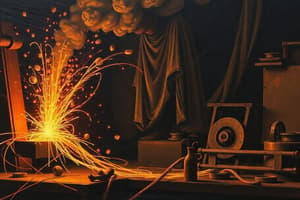Podcast
Questions and Answers
Which forming process is particularly suitable for reshaping lightweight metal pieces requiring high strength?
Which forming process is particularly suitable for reshaping lightweight metal pieces requiring high strength?
- Forging (correct)
- Rolling
- Rolling
- Casting
Which of the following processes is directly involved in altering the shape of metals without removing any material?
Which of the following processes is directly involved in altering the shape of metals without removing any material?
- Forming (correct)
- Slicing
- Joining
- Cutting
What characteristic feature of rolling distinguishes hot rolling from cold rolling?
What characteristic feature of rolling distinguishes hot rolling from cold rolling?
- Hot rolling is used for larger workpieces (correct)
- Thickness reduction only
- Cold rolling requires high temperatures
- Hot rolling increases metal strength
What is the significance of metalworking in modern times?
What is the significance of metalworking in modern times?
Which of the following is a common method employed in casting processes?
Which of the following is a common method employed in casting processes?
Which of the following is NOT a material commonly used in metalworking?
Which of the following is NOT a material commonly used in metalworking?
Investment casting involves which of the following steps?
Investment casting involves which of the following steps?
What method of joining metals is typically utilized for larger projects?
What method of joining metals is typically utilized for larger projects?
What is a key advantage of using die casting in metalworking?
What is a key advantage of using die casting in metalworking?
Which tool would you likely use for the cutting process in metalworking?
Which tool would you likely use for the cutting process in metalworking?
Which process is best suited for producing uniform thickness in metal sheets?
Which process is best suited for producing uniform thickness in metal sheets?
Which ancient civilization is reputed to have practiced metalworking as early as 8,700 BC?
Which ancient civilization is reputed to have practiced metalworking as early as 8,700 BC?
In sand casting, what material is commonly used for the mold?
In sand casting, what material is commonly used for the mold?
What is a common application of soldering in metalworking?
What is a common application of soldering in metalworking?
Which statement about forging is correct?
Which statement about forging is correct?
Which method involves the use of heat and pressure to reshape metal?
Which method involves the use of heat and pressure to reshape metal?
What is the primary purpose of milling in metalworking?
What is the primary purpose of milling in metalworking?
Which of the following processes uses heat and pressure to join materials?
Which of the following processes uses heat and pressure to join materials?
Drilling is primarily used for which of the following tasks in metalworking?
Drilling is primarily used for which of the following tasks in metalworking?
Which process is typically used for smaller materials like jewelry?
Which process is typically used for smaller materials like jewelry?
In which metalworking process is a cutting tool brought into contact with a rotating workpiece?
In which metalworking process is a cutting tool brought into contact with a rotating workpiece?
What technique uses molten metal poured into molds made from sand or plaster?
What technique uses molten metal poured into molds made from sand or plaster?
Which of the following is a primary function of grinding in metalworking?
Which of the following is a primary function of grinding in metalworking?
Which type of welding utilizes a filler material to create a joint?
Which type of welding utilizes a filler material to create a joint?
What is the main advantage of using CNC machines in metalworking?
What is the main advantage of using CNC machines in metalworking?
Which method is NOT typically associated with machining processes in metalworking?
Which method is NOT typically associated with machining processes in metalworking?
Flashcards are hidden until you start studying
Study Notes
Definition of Metalworking
- Metalworking involves forming and shaping metals to create tools, objects, equipment parts, and structures.
- Essential processes include forming, cutting, and joining, utilizing techniques like cutting, welding, casting, and molding.
- Materials typically used are ferrous (e.g., steel, iron) and non-ferrous metals (e.g., aluminum, gold, silver, bronze).
Historical Context
- Metalworking has a rich history spanning thousands of years, from ancient civilizations like the Egyptians and Mayans.
- The oldest evidence dates back to 8,700 BC, found in Iraq, showcasing early metalwork as a form of status communication and tool production.
- Ancient techniques such as soldering and welding remain relevant today.
- The extraction of metallic ores has been integral to human development, supporting advancements in technology and transportation.
Metalworking Techniques
Cutting
- Involves removing material from a workpiece using methods such as sawing, milling, and turning.
- Tools include hacksaws, milling machines, lathes, plasma cutters, and CNC machines, widely used in fabrication and construction.
Joining
- Combines metal pieces using heat through welding, effective for larger projects, and soldering, ideal for smaller projects.
- Welding techniques involve various processes (e.g., MIG, TIG) suitable for different applications.
Forming
- Re-shapes metal without adding or removing material, primarily through heat and pressure.
- Key methods include forging and bending, with the use of an anvil and hammer.
Casting
- Involves pouring molten metal into molds created from materials like stone or sand.
- Common casting methods include lost wax casting, die casting, and sand casting.
Cutting Processes & Techniques
- Various cutting methods range from handheld tools to advanced machinery.
Milling
- Precise machining process removing material with a rotating cutting tool.
Turning
- The workpiece rotates while a cutting tool moves in a linear motion to remove material.
Grinding
- Uses abrasives to refine surfaces and finishes, including handheld and advanced CNC equipment.
Drilling
- Creates holes in metal, requiring lubrication to preserve drill bits.
Joining Processes & Techniques
Welding
- Joins materials through pressure and heat with various welding types specific to applications.
Soldering
- Melts a filler material to join metals, typically used in smaller scale applications like electronics.
Riveting
- Utilizes rivets as permanent fasteners to create strong connections between metal pieces.
Forming Processes & Techniques
- Reshaping methods can be performed hot or cold, chosen based on metal type, equipment, and desired outcome.
Forging
- Heating metal followed by hammering to achieve the desired form; known for strength, especially in iron and steel.
Roll Forming
- Involves continuous bending of sheet metal using rollers, enhancing flexibility and precision.
Rolling
- Metal stock is passed through rolling mills to reduce or uniform thickness, performed hot or cold.
Casting Processes & Techniques
- Manufacturing solid metal objects by pouring molten metal into molds, offering cost and time efficiency.
Investment or Lost Wax Casting
- Created by shaping wax, encasing it in plaster, then pouring molten metal after wax removal.
Die Casting
- High-pressure injection of molten metal into machined molds, suited for alloys with low melting points.
Sand Casting
- Uses sand mixed with binding agents to create molds, known for its low cost and wide application in foundries.
Studying That Suits You
Use AI to generate personalized quizzes and flashcards to suit your learning preferences.





